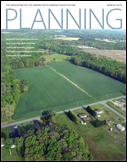Thanks to Kaid Benfield
(Thanks to Andrew A. for letting me know about this.)
Kaid is the director of the Smart Growth Program at the Natural Resources Defense Council. In the media column in the March issue of Planning Magazine, published by the American Planning Association, Kaid mentioned this blog first as a resource that 'make[s] me think in new ways.' He also said that 'you don't have to be a local reader to learn from his blog.'
That's always been my intent. To focus on processes, systems and "meta-learning" so that best practices can be:
(1) indicated -- figured out in terms of structures, processes, frameworks, etc.
(2) duplicated -- once you figure it out, you repeat the process somewhere else, successfully
(3) replicated -- after the best practice has been evaluated and repeated then it is able to be "diffused" more widely in other places, congruent with the framework, so that best practices work according to the local conditions, which are unique but still comparable across spatial and other conditions elsewhere.
DC is a great place to figure out things. (But so frustrating.)
One because we often do things so half-a**** that if you are good at figuring things out, you can't help but understand gaps in both formulation and execution. Two because DC is a strong market region, but DC is weaker than other jurisdictions in this metropolitan area, but in turn is stronger than other center cities that aren't too far away (Baltimore, Philadelphia, Richmond, Pittsburgh) so it allows for comparisons between strong and weak real estate markets. Third, because of the velocity of change. Things happen fast. My joke is that working on these issues in DC is like working in "dog years"--a dog lives the equivalent of 7 years in one year. Well, if you think and pay attention and are constantly learning and evaluating, you can learn a lot more than one year's worth of revitalization knowledge--if you are paying attention and are good at analysis.
Even in college I used to joke that you can learn more from dysfunctional organizations (then I was referring to student organizations as opposed to the University proper, and especially the student government) than from well-functioning organizations.
One more learning: that practitioners tend to not be very good at generating "meta-learning" and "meta-theory"--figuring out how and why they are successful (or not).
That's why I joke that I am too interested in application to be able to be fully happy in academia, and too interested in applying theory to (and extending) practice to be fully happy out in the field.

Labels: blog management, media and communications, sustainable land use and resource planning



0 Comments:
Post a Comment
<< Home